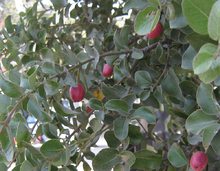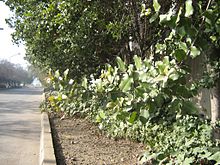- Cryptocarya
-
Cryptocarya alba Scientific classification Kingdom: Plantae (unranked): Angiosperms (unranked): Magnoliids Order: Laurales Family: Lauraceae Genus: Cryptocarya
R.Br.Species over 350; see text
Synonyms Cryptocarya is a genus of evergreen trees belonging to the Laurel family, Lauraceae. The genus includes more than 350 species, distributed through the Neotropic, Afrotropic, Indomalaya, and Australasia ecozones.
Contents
Overview
The genus includes species of evergreen trees, distributed mostly in tropical and subtropical regions of South America, Mauritius, India, China, Java , New Guinea, Africa and represented by 7 species in Southern Africa.
Common canopy very large trees to 60 m. or subcanopy trees in the succession climax species in tropical, lower temperate or subtropical broadleaved forest. Across communities of evergreen broadleaved forest and mixed coniferous-broadleaved forest. Found in low elevation evergreen forests and littoral rainforest, usually on all type of soils. The seeds are readily dispersed by fruit-eating birds, and seedlings and saplings have been recorded from other habitats where they are unlikely to develop to maturity.
The genus word Cryptocarya is from a Greek word krypto- meaning to hide, karya- meaning a walnut tree, the fruit of which was known as karyon, a word also used to other fruits. Sometimes are called Mountain laurels or Mountain walnuts. The fruit are succulent, partly immersed in a deep thick cup.
In a recent generic classification of Lauraceae based on DNA sequence data by Chanderbali et al. in 2001, was found to be part of a strongly supported clade that also includes Beilschmiedia, Potameia, Endiandra and Aspidostemon.[1]
Ecology
From large trees to shrubs, monoicous. The ecological requirements of the genus, are those of the laurel forest mostly from the tropics or warmer temperate areas, and like most of their counterparts laurifolia in the world, they are vigorous species with a great ability to populate the habitat that is conducive. The natural habitat of most of species are in rainforest which are cloud-covered for much of the year. These species are found in forests that face threats of destruction by human deforestation. Some species are in danger of extinction due to loss of habitat. Cryptocarya is a genus of great ecological importance. It is present in low rainforest and montane rainforest, laurel forest, in the Weed-tree forests in valleys, mixed forests of coniferous and deciduous broad-leaved trees. The differences are ecological adaptations to different environments over a relatively dry-wet and a warmer to mild frost (-2ºc) in temperate climate growing in cooler regions, subject to frost and occasional snow. Species in less humid environment are smaller or less robust, with less abundant and thinner foliage and have oleifera cells that give trees a more fragrant aroma. The most knowed trees are used by the timber industry. In this genus the wood of some species are having a high commercial value.
The species forming this genus share a unique paniculate inflorescence with the ultimate divisions that are not quite cymose; that is, the lateral flowers of what looks like a cyme are not strictly opposite, but tend to be subopposite, while in most genera of Lauraceae with paniculate inflorescences the lateral flowers in a cyme are strictly opposite.
The genus Ravensara, endemic to Madagascar, was described by Sonnerat in 1782, with the single species Ravensara aromatica. Kostermans maintained Ravensara in his treatment of the Lauraceae for the "Flore de Madagascar et des Comores" and in a later publication from 1958 in which he described an additional nine new species of Ravensara. Currently, the estimated number of species of Ravensara is about 30. Ravensara has always been considered closely related to Cryptocarya. Cryptocarya is also related to the Beilschmiedia clade and that, based on the presence of fruit included in the enlarged hypanthium, it is yet most closely related to Aspidostemon thought the similarity in fruit structure, in both Aspidostemon and Cryptocarya the fruit is enclosed in the enlarged hypanthium, might be a parallel development and not a signal of common ancestry. The fruit, a berry, is an important food source for birds, usually this birds are from specialized genus. Birds eat the whole fruit and regurgitate seeds intact, expanding the seeds in the best conditions for germination (ornitochory). In some species the seed dispersal is carried out by mammals.
Commercial selected species
The Chilean Cryptocarya alba and the Australian Cryptocarya erythroxylon and Cryptocarya foveolata of the mountains of New South Wales are outstanding for their frost tolerance within this genus having its majority of species growing in tropical climate. Cryptocarya woodii flowers in November with small inconspicuous flowers. These small flowers develop into round, shiny, purple-black fruits. This tree has a very hard brown wood. C. alba, the Peumo, is the most common evergreen tree in the Chilean Matorral ecoregion of central Chile and produces edible reddish fruits and is the most known species in the Northern hemisphere. Cryptocarya massoia is used commercially to produce essential oils. The bark of the tree Cryptocarya massoy contains a volatile oil comparable to cinnamon. C. alba produces a very hard wood which is highly esteemed.
Cryptocarya species
- C. alba Peumo (Chile)
- C. angulata Ivory Laurel (Australia)
- C. aristata
- C. ashersoniana (Brazil)
- C. chinensis
- C. chingii
- C. cinnamomifolia (Australia)
- C. concinna
- C. corrugata
- C. crassinervia (Indonesia)
- C. cunninghamiana Cunningham’s Laurel (Australia)
- C. densiflora (Indonesia)
- C. erythroxylon Pigeonberry Ash (southeast Australia)
- C. ferrea
- C. foetida Stinking Laurel (Australia). Vulnerable.
- C. foveolata Mountain Walnut (southeast Australia).
- C. gigantocarpa
- C. glaucescens Jackwood (Australia)
- C. grandis Cinnamon Laurel (Australia)
- C. hypospodia (Australia)
- C. invasorium
- C. laevigata Glossy Laurel (Australia)
- C. leptospermoides
- C. mackinnoniana Rusty Laurel (Australia)
- C. massoia (Indonesia)
- C. meissneriana (Australia)
- C. membranaceae
- C. micrantha Meisn. (Brazil)
- C. microneura Murrogun (Australia)
- C. moschata Nees et Mart. ex Nees (Brazil)
- C. multipaniculata
- C. murrayi Murray’s Laurel (Australia)
- C. natalensis = Dahlgrenodendron natalense (South Africa)
- C. nigra (Indonesia)
- C. nitens (Indonesia)
- C. oblata
- C. obovata (Australia)
- C. obtusifolia
- C. odorata
- C. palawanensis (Philippines). Endangered.
- C. pleurosperma Poison Walnut (Australia) Toxic and corrosive sap.
- C. pluricostata
- C. rigida Rose Maple (Australia)
- C. scortechinii (Indonesia)
- C. transversa
- C. tomentosa
- C. triplinervis Brown Laurel (Australia)
- C. vulgaris
- C. williwilliana Small Leaved Laurel (Australia)
References
External links
- Pictures of Cryptocarya alba or Peumo in Chile.
Categories:- Cryptocarya
- Laurales genera
- Trees
- Laurales stubs
- Tree stubs
Wikimedia Foundation. 2010.


